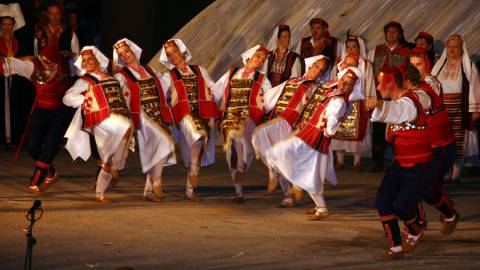Ethno Corner

Folk Costume of Vrlika
The folk costume of Vrlika is one of Croatia's greatest national ethnographic treasures. Not only the most recognisable part of ethnographic heritage, but it is also part of history. The first weavers borrowed the basic ornament from the early Croatian stone monuments, which they skilfully converted to both decoration and tradition. And it has continued like this for centuries.
Threads are strung together and colours are arranged, weaving and embroidering continues far into the night so that at the end everything would merge to form a unique folk costume for men and women, girls and children, a costume that has become an indispensable part of all ceremonies and important occasions, both religious and public. The chief characteristics of the mediaeval cultural inventory and tradition have been extremely well preserved in the folk costume of Vrlika.
The smooth and static patterns of the polychromatic embroidery create intricate ornamentation, very similar to that on the early Croatian stone monuments, and popular jewellery is almost identical to that found in the early settlement of Vrh Rika, so we can confirm that the folk costume of Vrlika has conveyed the main features of early Croatian cultural heritage to contemporary folk tradition, having preserved them until the very end of the second millennium.
Guardians of the Grave of Christ
The ancient custom of guarding the grave of Christ has been preserved to this day in Vrlika. In Holy Week, a group of men, members of the Guardians of the Grave of Christ brotherhood, takes part in rituals and processions on Good Friday, guarding the grave of Christ, because of which they are called gravediggers. Not only a religious ceremony, but this custom has also become cultural-historical heritage of the Croatian Catholics of the Vrlika region.
It is all about a deep religious sentiment and dedication to guarding the Most Holy Body of Christ in the period from placing it into the grave to the Resurrection. The whole procedure of guarding the grave of Christ takes place in a very solemn atmosphere, with participants dressed in traditional folk costumes of Vrlika and with traditional weapons that had for centuries been used by the people of Vrlika to defend their homes and their holy Catholic faith and its principles.
Strapping young boys and robust men add to the beauty of the mystery of the Passion of Christ, the Resurrection and victory. Their service is finished after Easter mass, when they dance the Kolo in front of church as a symbol of victory of Christ, resurrected from the dead, over evil and sin.
Nijemo Kolo of Vrlika
The silent circle dance of Vrlika, famous due to the history of the town, but also to perseverance of the Milan Begović cultural club, which aims to preserve the customs and traditions. The Nijemo Kolo is a folk dance most often performed in the Dalmatian hinterland. In November 2011, UNESCO included it on the Representative List of the Intangible Cultural Heritage of Humanity.
The Nijemo Kolo is a closed (not necessarily) circular dance, performed without music, although it can be either preceded or followed by vocal or instrumental performances. Nowadays it is most often performed on the occasion of religious or folk festivals.
The Nijemo Kolo of Vrlika is partly included in the Ero the Joker opera, composed by Jakov Gotovac, the libretto to which was written by Milan Begović. Here the dance is set to music and adapted for the opera. The rhythm of a variation of dancers of the Nijemo Kolo of Vrlika is accompanied in the opera by the rhythm of music and vocals.
Ojkanje Singing
The ojkanje is the oldest form of singing in Croatia. According to experts, it is a remnant of the pre-Slavic Balkan singing from ancient Dalmatia (today's Dalmatia, Bosnia and Herzegovina and Montenegro), which has been inherited and preserved by the Croatian people. In 2010, UNESCO's Intergovernmental Committee for the Safeguarding of the Intangible Cultural Heritage (ICH) included ojkanje singing on the List of Intangible Cultural Heritage in Need of Urgent Safeguarding.
The ojkanje is characterised by a specific shaking of the voice, achieved through a distinctive technique of singing ‘from the throat’. It is either performed by one singer alone or by the lead singer accompanied by another singer who performs the voice-shaking. Ojkanje two-part singing is found in the area between the Rivers Krka and Cetina, in Vrlika, Kijevo, the Drniš and the Šibenik hinterland. Not so long ago, people used this type of singing as a means of everyday communication while doing their chores or when travelling by horse-drawn carts, as an entertainment around the open fire during long winter nights as well as a way to pass the time while watching their grazing cattle.
Ojkanje singing owes its survival to organised groups of local folk singers who continue to transmit the skills and knowledge, performing at village festivals in Croatia as well as around the world. Nowadays, ojkanje is passed on and taught orally within organised folklore groups, but also through modern audiovisual media.




